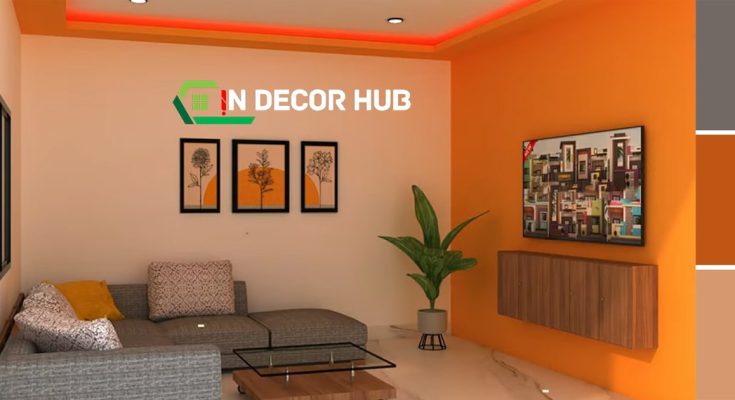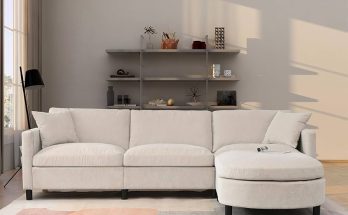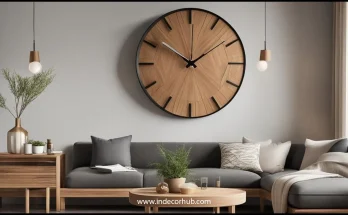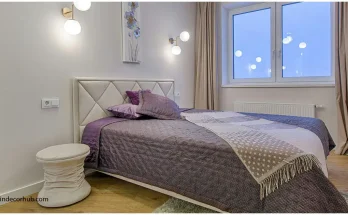Ideally, a room should feature three to five paint colors for a balanced and harmonious look. Selecting a palette within this range allows for depth and visual interest.
Decorating a room thoughtfully can transform it from a plain space into a cohesive and inviting environment. Choosing the right quantity of paint colors is crucial for developing a balanced aesthetic.
Three colors often serve as a standard guideline, allowing homeowners to designate a main hue, secondary shade, and accent tone to bring the room together.
These colors can define spaces, highlight architectural features, and ensure that the decor elements are cohesively tied together. Going up to five colors might be suitable for larger rooms or to achieve a more complex or layered design. Remember, this is not a strict rule, but a starting point for those who aim for a polished and well-designed space.
Table of Contents
1. Color Theory In Interior Design
Color Theory in Interior Design is essential for creating a cohesive and visually appealing space. When decorating a room, it is important to recognize the function each coloration plays and what number of ought to be present to achieve the preferred mood and fashion. Let’s discover how coloration theory can manual us to the precise shade palette for any room.
The Psychology Of Color
Colors have a profound effect on our feelings and behaviors. Here’s how different hues can affect the atmosphere of a room:
- Red: Injects energy and excitement
- Blue: Creates calmness and serenity
- Yellow: Invokes joy and stimulates the mind
- Green: Promotes balance and harmony
- Purple: Adds a touch of luxury and creativity
Color Harmony Basics
Selecting the right combination of colors is key for a harmonious space. The following ideas assist create a balanced coloration scheme:
- Analogous colors: Use colors adjacent to the color wheel
- Complementary colors: Pair colors opposite each other
- Triadic colors: Incorporate evenly spaced colors on the wheel
Typically, interior designers recommend using one dominant color, one secondary color, and one accent color to maximize harmony.
2. The Rule Of Three In Decor
The Rule of Three in Decor guides us in creating harmonious spaces. This unwritten decor rule suggests that things arranged in threes are more appealing. Color-wise, using three main hues can make any room balanced and visually interesting. When decorating a space, selecting a trio of colors can provide the perfect palette for a cohesive look.
Triadic Color Schemes
Triadic color schemes are one way to apply the Rule of Three. They involve using three shades that are flippantly spaced around the color wheel. This creates a vibrant, but balanced, palette this is visually compelling. Here’s how you can create a triadic scheme:
- Select a main color: This will be the dominant shade in your room.
- Find the two remaining colors: They lie at equal distances from the main color on the wheel.
- Apply them thoughtfully: Use the main color for walls or large items. The secondary colors can be accentuated through decor details.
Balancing Colors And Textures
Balancing colors goes beyond just the palette. To create depth and interest, blend a range of textures with your three colors. Aim for a mix of smooth, plush, rough, and glossy textures within your color scheme. Here’s a simple guide:
- Match textiles and upholstery with your primary color.
- Include decorative elements like pillows in your secondary colors.
- Add metallic or glass items for a contrasting texture.
Remember to distribute colors and textures evenly. This keeps the eye moving and the decor coherent. Such balance ensures each element stands out without overwhelming the space.
3. Dominant, Secondary, And Accent Colors
The art of choosing paint colors transforms a room’s decor. Land on the right mix, and the space comes to life. Use dominant, secondary, and accent colors to achieve balance and harmony. This guide helps navigate through each hue category.
Choosing A Dominant Shade
The dominant shade sets the room’s tone. It covers the largest area and anchors the space. When selecting, consider the room’s size, natural light, and purpose. Colors like beige, gentle gray, and blue create a relaxing backdrop for any room. Bold choices like deep green or navy add drama and depth. Follow these steps for a standout dominant shade:
- Check the color in natural and artificial light.
- Use paint samples on a large area of the wall.
- Consider the room’s furnishings and flooring.
Picking The Perfect Secondary Hue
A secondary hue complements the dominant. It should take up around 30% of the room’s color. This hue is ideal for accent walls and furniture pieces. Balance is key; ensure the secondary color supports the primary without overpowering it. Here’s how to pick a harmonious secondary hue:
- Choose a color that blends or contrasts well with the dominant.
- Consider the atmosphere you wish to create in the space.
- Experiment with lighter or darker shades of the dominant color.
Accent Colors For Impact
Accent colors give life and personality to a room. They are the cherry on top of the color palette. Often vibrant, these shades pop against the primary and secondary hues. Use them for accessories like cushions, artwork, or decorative objects. They make up about 10% of the room’s color scheme. Here are tips for impactful accents:
- Stick to one or two accent colors to maintain consistency.
- Try metallics or textures for a sophisticated touch.
- Consider the room’s theme when selecting accents.
4. Adding Depth With Neutrals
Adding depth with neutrals transforms a room into a soothing retreat. Neutrals serve as the foundation for color schemes, whether or not diffused or formidable. This approach creates harmonious areas with the right balance. Explore the effect of neutrals on domestic decor.
The Role Of Neutral Colors
Neutral colors are key to adding sophistication and versatility to interior design. They are the diffused heroes that carry together diverse elements inside a space. Implementing sun shades like beige, grey, and white allows for countless flexibility, placing a relaxed backdrop for layering textures and accessory colors.
- Anchor the space: Neutrals ground the room, anchoring colorful pieces.
- Create balance: They make vibrant colors pop without overwhelming the eyes.
- Timelessness: Classic appeal ensures your decor stays stylish over time.
Pairing Neutrals With Brights
Neutrals and bright colors make a perfect pair. Together, they create a dynamic but balanced space wherein each can shine without clashing. Consider the following tips:
| Neutral Shade | Bright Color | Effect |
| Soft Gray | Electric Blue | Modern Edge |
| Warm Beige | Coral Pink | Earthy Warmth |
| Crisp White | Emerald Green | Fresh Vibrancy |
- Pick a dominant neutral as the base.
- Add bright colors through art, pillows, or decor pieces.
- Use the 60-30-10 rule for color distribution (60% dominant color, 30% secondary color, 10% accent color).
5. The Effect Of Lighting On Colors
Choosing the right paint colors for a room is a task that can transform the space. It’s not just about the hue; lighting plays a crucial role. Different light sources can change how a color looks. This makes selecting the right type for each room all the more critical.
Natural Vs. Artificial Light
Natural light shows the truest color, so rooms with plenty of sunlight may need fewer colors to shine. South-facing rooms get more sunlight, which can handle more color variety. Lighter colors may be necessary in rooms that face north.
With artificial light, bulbs vary in color temperature. Warm white bulbs can make colors look warmer, while cool white often does the opposite. It’s vital to test paint samples in both lightings to see the effect.
Paint Finishes And Luminosity
Different paint finishes impact how light reflects and therefore, color perception. A gloss finish reflects more light, making the room brighter. Matte finishes absorb light, appearing softer and more uniform.
| Finish | Light Reflection | Room Suitability |
| Gloss | High | Bathrooms, Kitchens |
| Satin | Moderate | Living Rooms, Bedrooms |
| Matte | Low | Bedrooms, Ceilings |
Choose a finish that complements the room’s lighting conditions. Testing different finishes under both natural and artificial light helps make the best choice.
6. Maximizing Small Spaces With Color
Decorating a small space is a creative challenge. Colors can transform how a room feels. They can make it look larger and more welcoming. Let’s explore how to maximize small spaces with color.
Light Hues For A Spacious Feel
Your choice of paint color is key to making a small room feel bigger. Light hues are your best friend in compact spaces. Think soft whites, pale blues, and gentle grays. These colors reflect light, making walls seem further away. This tricks the eye into seeing a more airy room. Let’s flash a spotlight on how light hues can uplift your space:
- White: It broadens a room, evoking a feeling of openness.
- Pastels: Soft colors bring a sense of calm and lightness.
- Neutrals: They offer flexibility, pairing well with various decor items.
Cohesive Color Flows
Creating a smooth color flow is crucial. It keeps your space from feeling choppy. Select colors that belong to the same family to create a cohesive effect. You can also use a single color but vary its shades across the room. This builds depth without overwhelming the space. Below are some strategies for a cohesive color scheme:
- Use Tints and Shades: Pick a base color. Mix in lighter tints or darker shades to add interest.
- Transition with Accents: Select one or two accent colors. Use them in accessories like pillows and art.
- Consistency is Key: Maintain the same color palette throughout the room to enhance unity.
When colors flow well, rooms come alive. Even the tiniest of spaces can feel like a cozy retreat. Embrace the magic of color to turn your small room into a stylish haven.
7. Creating Mood With Color Choices
Color can transform a room. Not just its look, but how it feels. When picking paint for a room, colors aren’t just decoration—they create moods. Should you go bold or soft? One hue or several?
The colors you choose set the stage for the room’s vibe. A bedroom might need calm, soothing tones. A study may benefit from colors that spark creativity or focus. Below are some common room types and recommended colors to set the emotional tone:
| Room Type | Color Mood | Suggested Colors |
| Bedroom | Calm/Relaxed | Soft blues, lavender, pale green |
| Study/Home Office | Inspiring/Productive | Deep green, bright orange, eggplant |
Colors can change our behavior and mood. Here’s how some colors can influence a room:
- Red: Energizes, and increases appetite. Great for dining rooms.
- Yellow: Stimulates joy. Brightens living rooms or kitchens.
- Blue: Calms, and lowers blood pressure. Ideal for bedrooms or bathrooms.
Remember to choose colors that connect with the room’s purpose and the feelings you want to evoke.
8. Cultural Influences On Color Selection
Choosing the right paint colors for a room is an art. Colors speak silently but powerfully. The number of paint colors in a room depends on various factors. Culture is a big one. Different cultures see colors in special ways. This can impact your paint color choice.
Colors And Their Historical Contexts
Every color has a story. Its meaning changes from one place to another. Long ago, some colors were hard to make. This made them expensive and rare. Only rich people used them. Think of royal blue or imperial purple. Today, these colors still feel luxurious and powerful.
- Red in China signifies luck and happiness.
- In Egypt, blue was divine and fit for pharaohs.
- Native American cultures use green as a sacred color.
Global Trends In Interior Colors
Design trends go around the world. What’s popular in one place can show up across the globe. Interior designers often look at global hotspots for inspiration. These trends can guide which colors end up on your walls.
| Region | Trending Color |
| Scandinavia | Soft pastels, clean whites |
| Mediterranean | Warm terracottas, ocean hues |
| South America | Bright yellows, vibrant blues |
A room can reflect these influences. Blend local culture with global trends. Balance historical colors with modern hues. The right mix brings harmony to your space. Your room can have as many colors as you like. But remember the power of culture in your choice.

9. Incorporating Patterns And Prints
When decorating a room, choosing the right paint colors is just one piece of the puzzle. Incorporating patterns and prints can bring life and personality to your space. The key is knowing the way to do it without overwhelming the room. Whether you’re running with stripes, florals, or geometric prints, permit’s explore the way to manipulate these designs efficaciously.
Managing Color With Busy Designs
Busy designs can transform a room from bland to beautiful. However too much color and pattern can make a room feel chaotic. Start with a neutral paint color if you have a busy pattern. This creates balance. Use your pattern as an accent rather than a base. Consider the following tips:
- Choose one main pattern to dominate the room.
- Limit the color palette within that pattern to maintain harmony.
- Use smaller patterns or solids for furniture and accessories.
- Select colors from the same family or that complement each other.
Balancing Bold Patterns
Bold patterns make a statement but require careful handling. To ensure they add drama without overpowering a room, use them sparsely. Here are some strategies to maintain balance:
| Pattern Type | Application | Tips |
| Large prints | Accent wall | Pair with solid colors on other walls. |
| Stripes | Furniture pieces | Keep walls a single shade. |
| Abstract | Decor items | Use neutrals as a backdrop. |
Remember, each pattern should have at least one color that links back to your base color. This creates a cohesive design. Aim to have no more than three patterns in a room. Align the scale of patterns with the size of your space. Small rooms benefit from smaller patterns, while large rooms can handle bolder prints.
10. When To Break The Color Rules
Decorating a room brings a canvas of creativity. Rules often dictate three to five paint colors for harmony. Yet, unique spaces shimmer when these guidelines bend. The key to using more colors lies in balance and intention. Not all rooms must follow the traditional path. It’s about the feel you wish to evoke. For the daring decorator, here’s when to rewrite the color playbook.
Experimenting With Eclectic Mixes
Imagine a space that tells a story through hues. Eclectic mixes encourage a bolder palette. Create a harmonious blend by anchoring with a neutral base. Then, introduce a spectrum of accents. Contrast warm and cool tones for vibrancy. Consider these points for an eclectic room:
- Color blocking: Use separate colors on different walls or furniture pieces.
- Textures: Combine matte, glossy, or metallic finishes.
- Patterns: Introduce various patterns to add visual energy.
Personal Style Over Precedent
Your home should reflect who you are. Let your style make the statement. Steps to ensure personal style shines through include:
- Favorite colors: Start with colors you love, regardless of trends.
- Art inspiration: Draw color ideas from a beloved piece of art.
- Moods: Select colors that evoke desired feelings.
11. The Importance Of Test Swatches
The Importance of Test Swatches holds a special place in the journey to the perfect room decoration. Picking a paint color for a room is exciting. Yet, it can feel overwhelming with endless options. Sample test swatches bridge the gap between guesswork and the final paint job. They let you preview your color choices on your walls without commitment.
Sampling Before Committing
Imagine choosing a paint color, only to dislike it after the room is done. Unlike small decor items, repainting is costly and time-consuming. This is in which test swatches are available.
- Save Time: Test different shades quickly without painting the whole room.
- Cost-Effective: Investing in samples is cheaper than buying gallons of the wrong paint.
- Accuracy: See the actual paint, not a printed color, against your room’s lighting and decor.
Observing Color At Different Times Of Day
Light changes the way colors look. A color might seem perfect in the morning but not at night. Observing test swatches at different times ensures you choose the right color.
| Time of Day | Lighting Condition | Color Appearance |
| Morning | Natural Light | True to Tone |
| Afternoon | Bright Light | Enhanced Brightness |
| Evening | Artificial Light | Darker or Warmer |
Place swatches in areas with different lighting conditions. Check them at various times to see changes. This helps you make a confident decision on your room’s best paint color. Aim for a color that looks good all day.
12. Final Touches With Furnishings And Decor
The final touches with furnishings and decor play a crucial role in bringing a room’s color palette and design together. This stage can add personal flair and comfort that makes the space feel complete. The right combination of furniture and decorative accents can enhance the harmony within your chosen color scheme or introduce the desired contrast to create a striking visual impact.
Matching Furniture To The Color Scheme
Selecting furniture that aligns with your room’s color scheme is essential. It ensures a cohesive feel. Here’s how you can match your furniture flawlessly:
- Identify the dominant color: This should be the lead in your choice of furniture.
- Opt for complementary shades: Furniture in tones that are adjacent to the color wheel works well.
- Use neutrals to balance: If the wall colors are bold, neutral furniture can offer rest for the eyes.
Decorative Accents That Complement Or Contrast
Decorative elements are the dynamic touch that can either tie everything together or introduce an element of surprise. Follow these tips:
| Accent Type | Complementary Approach | Contrast Approach |
| Cushions | Choose colors from the same palette as your walls or furniture for harmony. | Opt for contrasting colors or patterns for a pop of interest. |
| Artwork | Art that reflects the room’s scheme can be soothing to the eye. | Bold and unexpected art choices can serve as conversation starters. |
| Rugs | Pick a rug that subtly includes the room’s main colors. | Choose a rug with a contrasting color to define the space. |
Whether you aim for complement or contrast, ensure every piece has a purpose. Your chosen accents should represent your style while respecting the color narrative of your space.
13. Frequently Asked Questions For How Many Paint Colors Should Be In A Room When Decorating?
What’s The Ideal Number Of Paint Colors Per Room?
Selecting two to three paint colors for a room creates a balanced and harmonious atmosphere.
Does Adding More Colors Affect Room Aesthetics?
Excessive colors can overwhelm a room, causing visual clutter. For elegance, it is necessary to maintain a cohesive color scheme.
How Do Accent Colors Influence Room Decor?
Accent colors add depth and interest, enhancing a room’s overall appeal when used sparingly as part of the decor.
Can One Color Suffice For A Room Design?
Using a single color can work if varied with different tones and textures to prevent a monochromatic space from feeling flat.
14. Conclusion
Deciding on the right number of paint colors for a room boils down to balance and personal taste. Aim for harmony in your decor, often achieved with three to five colors. Remember, an appropriate palette displays your style while enhancing the room’s layout factors.
Trust your instincts and create a space you’ll love.



